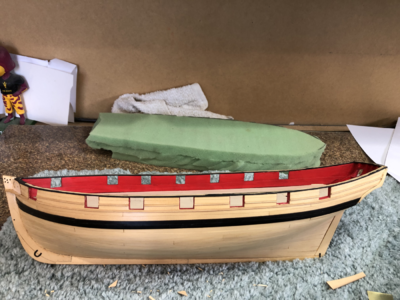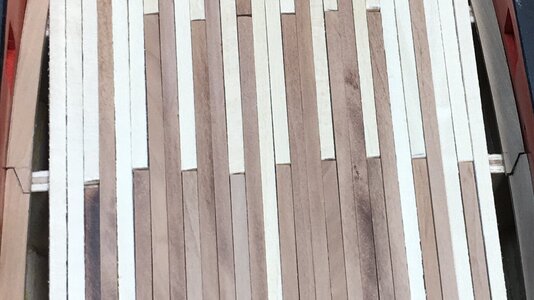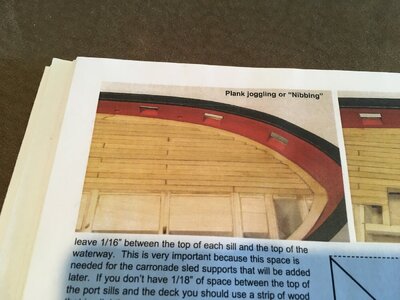Thank you Uwe, I really appreciate the wishes and it’s a good time to thank you for all you do for this excellent forum.
-

Win a Free Custom Engraved Brass Coin!!!
As a way to introduce our brass coins to the community, we will raffle off a free coin during the month of August. Follow link ABOVE for instructions for entering.
-

PRE-ORDER SHIPS IN SCALE TODAY!
The beloved Ships in Scale Magazine is back and charting a new course for 2026!
Discover new skills, new techniques, and new inspirations in every issue.
NOTE THAT OUR FIRST ISSUE WILL BE JAN/FEB 2026
You are using an out of date browser. It may not display this or other websites correctly.
You should upgrade or use an alternative browser.
You should upgrade or use an alternative browser.
Syren 1803 1:64 Model Shipways
- Thread starter RogerD
- Start date
- Watchers 60
-
- Tags
- model shipways syren
Awesome Roger! Hope you have a great day celebrating with family and friends!
Hi Paul, thanks. The day started off with incoming calls from very distant family and friends far and wide. The rest of the day will be for reading, model building and, of course, reflective moments.
I do not know how I missed that posting on Wednesday. Apologies Roger. Your Syren looks exquisite with the red beautifully offsetting the black wales while the rest of the woodwork is just superb! When that deck is planked - and I know that you will create a stunning deck - that whole ship is going just going to "pop"! And then not even to talk about the black and red deck ancillaries.
And then of course: Happy Birthday my friend! May you be granted a year full of health that you can enjoy with your loved ones and treat us on beautiful model building!
Thank you for your valued comments Heinrich and my goodness with your ever present support there is absolutely nothing to apologize for. That red and black paintwork certainly “pops” with a colourful and almost dramatic effect on the model. The pear deck will provide a more subdued tone as will the profusion of furniture and fittings. I am eager to get going on the deck but, of course, there is planning and reading to do.
Thank you also for the birthday wishes, I always welcome this day as the years roll by.
Happy BDay Roger!
Thanks Ken, I appreciate the kind wishes.
Happy Birthday, Roger!
Thank you Jim, I’m glad to see the cake icon has very few candles on it
She's looking lovely Roger. But remember that when using softer woods it isn't necessary to simulate chaulking as the stain will darken the joints as the soft wood absorbs the stain. AYC is harder than basswood but still absorbs the stain. On my model Cheerful I didn't add caulking and the blow photo shows the seams with only one coat of wipe-on-poly on AYC.


She's looking lovely Roger. But remember that when using softer woods it isn't necessary to simulate chaulking as the stain will darken the joints as the soft wood absorbs the stain. AYC is harder than basswood but still absorbs the stain. On my model Cheerful I didn't add caulking and the blow photo shows the seams with only one coat of wipe-on-poly on AYC.
View attachment 316936
Hello Will, thanks for the support and advice.
In my case the hull is all constructed from basswood. I only used AYC for the inner bulwark planking. When I did the upper planking above the wales I did not simulate caulking. I originally intended to paint that area, changed my mind after finishing the planking and stained instead. By chance the stain, as you mention, tended to darken the joints so I sort of escaped that potential problem
Nice job on your Cheerful build above, I have come to really like that Alaskan Yellow Cedar.
Last edited:
Good evening Roger. A day late - I hope you enjoyed a magic day Roger. If your birthday was half as good as your Syren then you had a special one. Cheers Grant
Hello Grant, thank you for the wishes and wonderful compliment. I did indeed have a magical day  .
.
Symmetry in deck planking.
How important is it to have symmetry in the deck planking layout port and stbd? In other words, and as an example, if a plank butt ends say three planks inboard from the margin plank on the port side but a corresponding butt on the same bulkhead is offset two planks inboard from the stbd side margin plank is this a no, no?
Maybe a picture will help. Please note this is just random pieces of scrap wood, very roughly shaped, nothing is glued, not joggled but loosely positioned and fitted to try out a deck pattern. If I sneeze all the planks will blow off the deck

Thanks for any responses, help, advice, critiques, and information.
How important is it to have symmetry in the deck planking layout port and stbd? In other words, and as an example, if a plank butt ends say three planks inboard from the margin plank on the port side but a corresponding butt on the same bulkhead is offset two planks inboard from the stbd side margin plank is this a no, no?
Maybe a picture will help. Please note this is just random pieces of scrap wood, very roughly shaped, nothing is glued, not joggled but loosely positioned and fitted to try out a deck pattern. If I sneeze all the planks will blow off the deck


Thanks for any responses, help, advice, critiques, and information.
Not sure about symmetry. Some ships and many boats have it, but for early warships it appears to be of lesser concern than just placing the planks in such a pattern that they have strength. On my models, I don't reverse the planking pattern as you cross the centerline, but continue the 4 plank shift pattern from port to starboard. It would be interesting to see how Wasa was planked, since it's the only large man of war from that era to survive. As for symmetry, it's my guess that the builders cared more for the framework being symmetrical than the planking pattern of the decks. A significant effort seems to have been made to make the hull planking symmetrical.
Thanks Paul. Photos of Wasa show they used wood of so many different sizes, but the pattern was not evident from the photos. I guess for that ship, they were just interested in making sure as few end joints lined up as they could with the wood they had.I can't answer your question for the Syren other than to say if you are laying down a pattern just stick with that pattern - any side to side difference would then fade into the background (just my opinion not stating fact).
And to answer Kurt's question...
View attachment 321998
Complete chaos...
A great response to my question, thanks Kurt. I agree about structural deck strength. The designer of the Syren model shows in his manual the first two planks from the centre line laid such that the port one has it’s butt on the third bulkhead from for’d. Obviously the stbd plank then has to be offset to the next convenient bulkhead. He suggests plank lengths for every four bulkheads with some leeway though. In a couple of cases he stretches to six bulkheads but I feel then that those planks might be unrealistically long. His use of the bulkheads removes the issues of butts being unsupported as if on frames.
Maybe a photo from his manual will show how the deck pattern as laid will, by necessity I think, mean unsymmetrical plank butts.

Maybe a photo from his manual will show how the deck pattern as laid will, by necessity I think, mean unsymmetrical plank butts.

Yes, I think that's right Kurt. On both the decking and the hull planking Wasa does not show a standard plank shift or pattern. I read they simply used the available material to its best advantage.Thanks Paul. Photos of Wasa show they used wood of so many different sizes, but the pattern was not evident from the photos. I guess for that ship, they were just interested in making sure as few end joints lined up as they could with the wood they had.
Yes, thanks Paul. I have played with deck patterns for a couple of weeks now. Checked books, monographs, logs, photos and so on and most show that butt symmetry I asked about. There is one other way, actually two ways, nope three ways around it.I can't answer your question for the Syren other than to say if you are laying down a pattern just stick with that pattern - any side to side difference would then fade into the background (just my opinion not stating fact).
And to answer Kurt's question...
View attachment 321998
Complete chaos...
1. Build all the deck structures and fittings first. Then lay the deck planks around them. That way I think I can get a symmetrical arrangement.
2. Lay a king plank but I cannot find if that would be realistic for 1803.
3. Do a Wasa/Vasa
- Joined
- Oct 9, 2020
- Messages
- 2,212
- Points
- 488

About deck symmetry. Did you start the planking with the middle and then worked your away outwards? Meaning you do port side then starboard then port then starboard etc?
Hi Jack, those loose test planks were laid to give me an idea of where butts would fall. The manual shows one plank each side of the centre line. The first on the port side lands on bulkhead three (L on the plan). The first stbd one lands on bulkhead five (D on the plan). That butt shift throws off the deck butt pattern at the port and stbd sides but as Paul said it probably will not be noticed.About deck symmetry. Did you start the planking with the middle and then worked your away outwards? Meaning you do port side then starboard then port then starboard etc?
I laid the planks alternately port and stbd to see how they would look. If I do the actual planking that way I will probably alternate in much the same way to make sure my planks run straight and true.
- Joined
- Oct 15, 2017
- Messages
- 1,190
- Points
- 443

Great work Roger! I admire the depth of your research with the goal of following real hull planking rules and practices. I've read your build thread and forgive me if I've missed someone already suggesting. You could follow butting planking rules if you if you simulate the butt ends where they fall on the faux frames. When they fall on bulkheads use real butted ends. It does depend on your plank thickness and the thicker the plank the easier it is to pull it off. Normally, single planked hulls use thicker planks and hence my suggestion.
Whatever you decide, I'm quite certain you will end your planking journey with great results.
Whatever you decide, I'm quite certain you will end your planking journey with great results.

Great work Roger! I admire the depth of your research with the goal of following real hull planking rules and practices. I've read your build thread and forgive me if I've missed someone already suggesting. You could follow butting planking rules if you if you simulate the butt ends where they fall on the faux frames. When they fall on bulkheads use real butted ends. It does depend on your plank thickness and the thicker the plank the easier it is to pull it off. Normally, single planked hulls use thicker planks and hence my suggestion.
Whatever you decide, I'm quite certain you will end your planking journey with great results.
That’s another good alternate suggestion Ken. I’ll do a small deck plank mockup and see how simulated butt ends look near actual butts. My pear planks are 1/16” thick by 1/8” width so a small depth cross-cut with a very thin blade might work or a fine razor saw. With a simulated nail pattern I may end up with the deck looking like it’s been shot blasted though
Thanks, I appreciate your supportive words.



